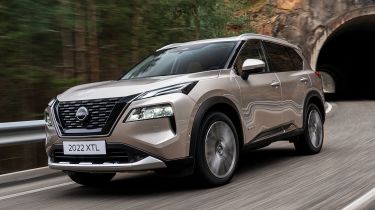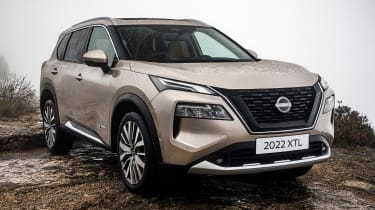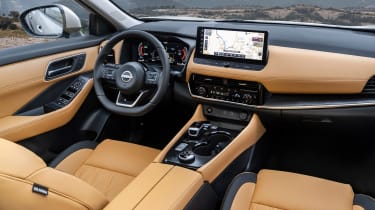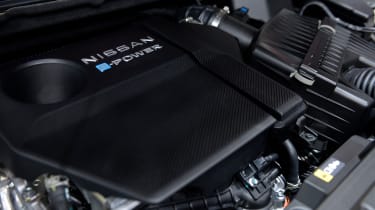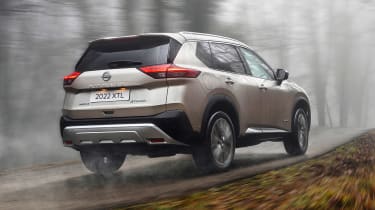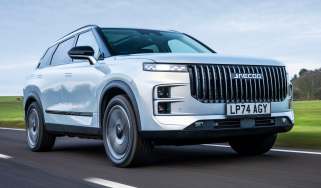New Nissan X-Trail on sale now: full prices and specs
You can now order the Nissan X-Trail, which comes with the same e-Power hybrid tech as used on the Qashqai.
- 12.3-inch infotainment
- Hybrid-only in the UK
- Starts from £32,030
After nearly 10 years of the outgoing model, Nissan has finally released a new version of the Nissan X-Trail mid-size SUV. Orders are now open for the X-Trail via Nissan’s website, with deliveries set to begin in October. Prices start from £32,030 for entry-level Visia models and £42,520 for the top spec Tekna+.
The Nissan X-Trail sits on the same e-Power hybrid underpinnings as the smaller Nissan Qashqai and has a bolder design than before, with updated technology. It comes with a 1.5-litre petrol engine used solely as a range extender to charge the car’s battery by generating electricity – the electric motors alone drive the wheels.
 Top 10 best hybrid SUVs in 2025
Top 10 best hybrid SUVs in 2025
This version of the X-Trail is capable of 201bhp in single-motor two-wheel-drive form, or there’s the e-4ORCE four-wheel-drive version, which uses an added motor on the rear axle for a 210bhp output and faster acceleration.
The X-Trail will be the first vehicle to use Nissan’s new e-4ORCE all-wheel-drive system in Europe. The same system will be used on the ARIYA in 2023.
Nissan will also offer the X-Trail with a two-wheel-drive mild-hybrid setup, which consists of a 1.5-litre petrol engine driving the wheels in a more conventional way, with electric motors helping to increase fuel efficiency. These models will be capable of a power figure of 161bhp.
2022 Nissan X-Trail: design and exterior
Available with five or seven seats, the Nissan X-Trail will take back its position at the top of Nissan’s SUV line-up, so it’s unsurpring it takes several design cues from the latest iteration of the Qashqai; the X-Trail gets that car’s distinctive split headlight design which runs into the brand’s signature ‘V-Motion’ trapezoidal grille.
Looking at the design overall, however, the X-Trail is much chunkier than its Qashqai sibling. There is more-prominent plastic body cladding along the wheel arches to give the car a wider and tougher look, plus the taller, flatter roofline is something more akin to a dedicated 4x4 rather than a family crossover.
Interior & technology
The interior of the fourth-generation Nissan X-Trail represents a huge upgrade over the outgoing model. Overall, the new X-Trail’s interior appears a lot more modern and premium than the car it replaces, with a 12.3-inch touchscreen infotainment system mounted on the dashboard, surrounded by plush leatherette trim. This is bolstered by another 12.3-inch display in the form of a digital instrument cluster; both screens are configurable to show information relevant to the driver such as media, navigation and engine instrumentation.
Higher-spec versions of the X-Trail are set to be fitted with the next generation of Nissan’s full ProPilot suite of assistance systems. This includes features such as adaptive cruise control, lane keep assist, traffic jam assist, automatic high beams and traffic-sign recognition.
As before, the Nissan X-Trail will be offered as a seven-seater. However, thanks to the new CMF-C underpinnings, it has been designed to simultaneously house a hybrid powertrain as well. In the front row, the driver and passenger will be pampered by Nissan’s ‘Zero Gravity’ seats, which are designed to enhance comfort on longer journeys. These can be specified in Nappa leather or a water-repellant “Cell-Cloth’.
Engines and powertrains
The new Nissan X-Trail will be offered as a self-charging hybrid and a mild-hybrid in the UK; at this stage, Nissan has revealed no plans to sell a conventional petrol or diesel model. The X-Trail’s hybrid setup consists of a 1.5-litre four-cylinder petrol engine used solely to generate electricity for the car’s electric motors, which power the wheels.
The two-wheel drive e-Power models will be capable of a 0-62mph time of eight seconds. The four-wheel drive e-4ORCE models will be quicker at seven seconds for the five-seater version and 7.2 seconds for the seven seater, thanks to the extra electric motor on the rear wheels. The e-4ORCE system offers several different off-road driving modes and increased capability thanks, once again, to the added torque from the electric motor.
The mild-hybrid version’s 1.5-litre petrol engine works much like a conventional mild-hybrid, with electric motors used to improve the efficiency of the combustion engine. These models will generate 161bhp, with a 0-62mph time of 9.6 seconds.
The most fuel efficient version of the X-Trail will be the two-wheel-drive e-Power model, with a maximum efficiency figure of around 48.6mpg. This is slightly lower on the four-wheel drive e-4ORCE models, with the five-seater version’s official best figure being 44.7mpg and the seven-seater capable of up to 43.8mpg in the official tests. The least fuel efficient models are the mild-hybrid versions, with a maximum fuel efficiency of almost 40mpg for the five-seater and just over 39mpg for the seven-seater.
Nissan claims the new car will drive much like a full EV thanks to the instant power from the electric motor, plus the brand’s new e-Pedal driving system. This, much like in a fully-electric car, uses the regenerative effect of the electric motor when coasting to recharge the batteries and slow the car down – therefore, one-pedal driving should be possible in the X-Trail.
What does this mean for car buyers?
The third-generation of X-Trail already felt outdated years before it was discontinued in 2021, so this new model is well overdue. Thanks to its hybrid powertrain, the X-Trail should appeal to those wanting to save money on running costs over petrol-powered rivals such as the Skoda Kodiaq. Yet, it is worth noting that the new car will cost significantly more than the outgoing model and the lack of a plug-in hybrid variant means the new X-Trail will have limited appeal to company car drivers.
Looking for a spacious new family car? Check out our list of the top 10 best large SUVs
Recommended

New Subaru Trailseeker revealed as rugged electric SUV with 375bhp

New Subaru Solterra brings more range, power and polish
Most Popular

Beat the Easter weekend traffic: secrets of a stress-free car getaway
Tips & advice

Car dashboard warning lights: what does each symbol mean?

Electric car charging stations: public networks, charger types, apps and maps


